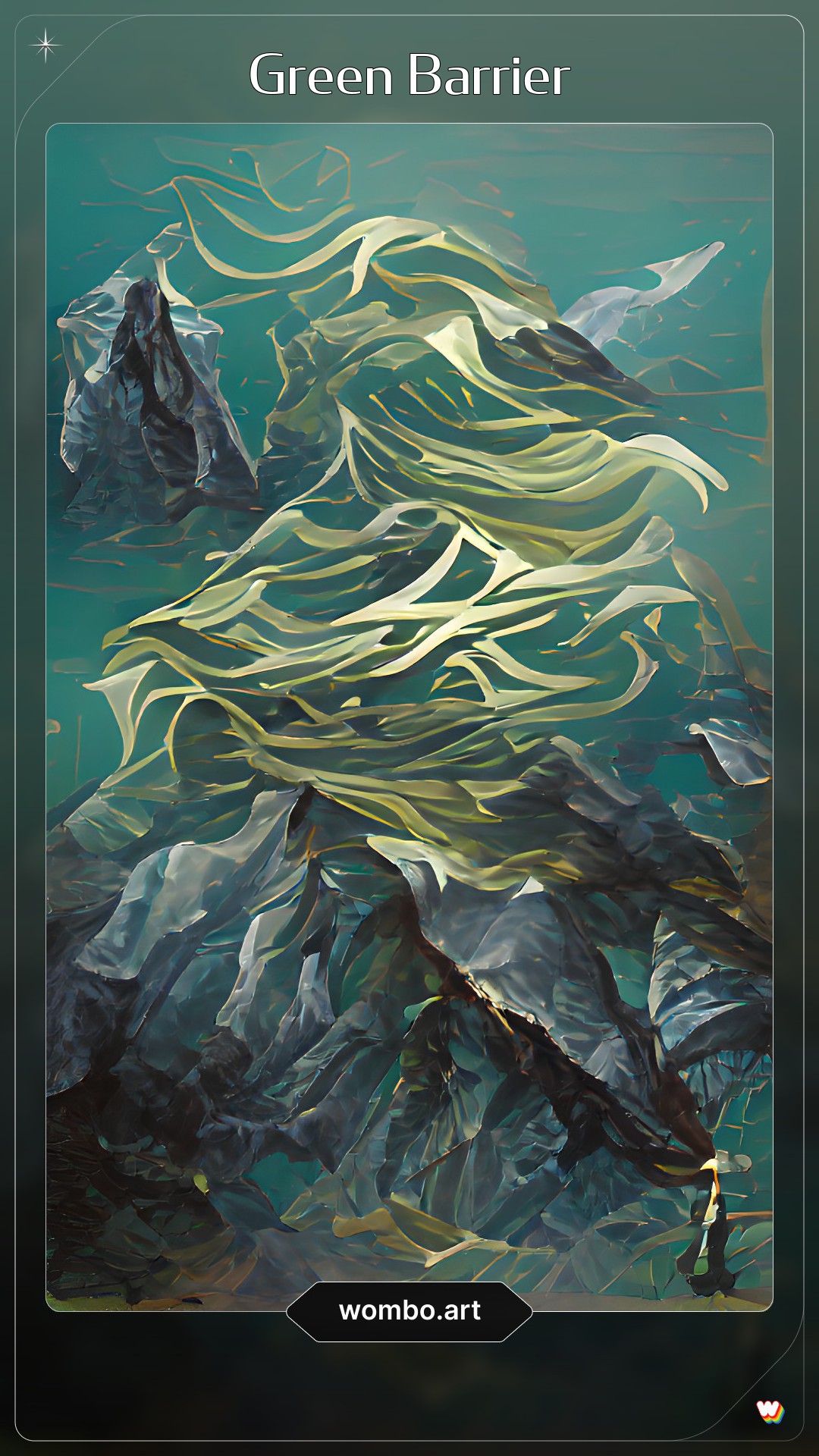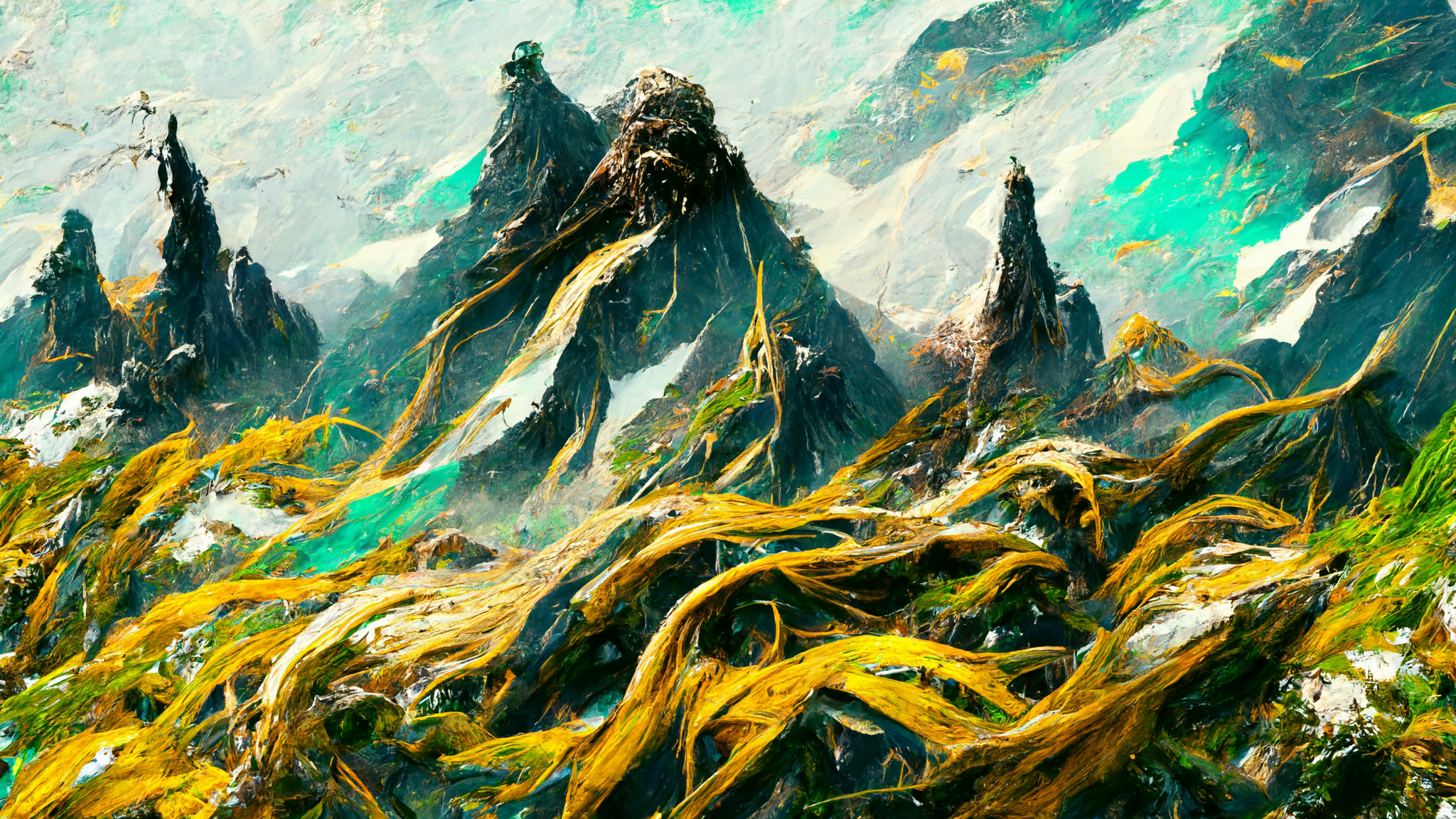Green Barrier
As the only mountains I've personally seen, I might've thought it normal to have green peaks.
Located in the geographic center of the Aemark Kingdom, the Green Barrier's peaks are visible from as far away as Sensancel in the northwest to Venprenta in the southeast. Nobles in Aemark City with sufficient wealth may own towers high enough to see beyond the Daymark Forest and Hills to glimpse its majesty. The characteristic coloration unique to the range is due to a species of flora covering the majority of the slopes, extending to its uppermost reaches in many cases.
 The Barrier runs in a swooping U-shaped pattern from the northwest near the Old Ironshaft Mine to its southernmost edge by the Elven Conclave and returning to the north on the opposite bank of the northeastern tributary of the Aeclind River. Within the 'U' lies the Arid Flat.
Bordering the western range and across the valley, the Singing Forest runs almost its full extent, leaving just a small part to the east of the Conclave empty. Artists are fond of capturing the Green Barrier from the banks of the Aeclind. It is rather common to encounter painters in Venleif working on their pieces by the water's edge, usually facing north during sunset to better view the interplay of woods, water, and rays of sunlight falling on the slopes.
The Barrier runs in a swooping U-shaped pattern from the northwest near the Old Ironshaft Mine to its southernmost edge by the Elven Conclave and returning to the north on the opposite bank of the northeastern tributary of the Aeclind River. Within the 'U' lies the Arid Flat.
Bordering the western range and across the valley, the Singing Forest runs almost its full extent, leaving just a small part to the east of the Conclave empty. Artists are fond of capturing the Green Barrier from the banks of the Aeclind. It is rather common to encounter painters in Venleif working on their pieces by the water's edge, usually facing north during sunset to better view the interplay of woods, water, and rays of sunlight falling on the slopes.
Geography

Green Barrier by Wombo ("Mountains Heights
Kelp Green")
Kelp Green")
Nearby Settlements
Because of the local weather and climate, the Green Barrier contributes a significant amount of water to the Aeclind from the runoff of showers landing on the mountainsides. As with all major waterways, people settle upon its banks:- Venleif: Though the river is far more important to the trading town than the range, the combination of fine wines and inspiring views result in a notable amount of tourism devoted to viewing the mountains from the comfort of the Lord's manor or high-end establishments situated to take advantage of the picturesque landscapes as part of the dining experience.
- Grand Arcane Academy: For professors and scholars, the range is surprisingly important. Botanists continue to spend years researching the plants covering the Barrier. The institution, while not traditionally a location for conventional study, offers lodging for said individuals in the hopes the resulting findings could be leveraged for alchemy.
- Elven Conclave: The elves of the Conclave, having received minimal support from the Kingdom, eagerly hunt fauna local to the mountains, which provides an important source of meat in an otherwise mostly vegetarian diet. Skins and hides from the animals contribute modestly to their trade, which are 'donated' to the military for use in armor or makeshift camps.
Ecosystem
The ecosystem of the enclosed 'U' of the mountains, called the Arid Flat slopes, is vastly different than those without and marginally different between the eastern and western ranges. Of the three regions, the eastern is generally regarded as the most ecologically diverse (and dangerous).Arid Flat Slopes
The mountainsides facing the Flat have considerably less coverage of the 'mountain kelp,' which contrasts with the 'Green' moniker given to the formations. The exception is the eastern range, whose Flat-facing side retains a high proportion of flora owing to the unique weather patterns of its eastern side. For the western range, the cold, dry air and receding plant life limits the density and diversity of fauna. Rodents, small cats, and rabbits are the most common terrestrial animals seen by scholars and hunters. More challenging to study, birds are much more prevalent due to their ability to cross from the opposing side of the mountain where they nest. Though larger species are more likely to fly to the Singing Forest instead of to the Arid Flat slopes, the decreased competition for sustenance, and smaller number of predators, is appealing for diminutive animals.Western Range
The waters of the Aeclind contribute to significant amounts of animal and plant life along the Green Barrier, further enhanced by the rains upon the mountainside. At the top of the peaks, the kelp reigns supreme, but largely by itself until temperatures rise to near freezing instead of well below. Mountain goats are especially common across the entirety of the western range and frequently travel from the snow line down to the river and back again throughout the course of a week. They subsist on the greenery at higher altitudes quite readily as there is little competition. With abundant prey, leopards hunt either in solitude or in pairs, traversing the rocky facades in pursuit of a tantalizing meal. Nearer the river, bears feast on fish, but many hibernate in caves near the base of the mountains. Of note amongst the avian species native to the Green Barrier is the blood hawk. Aggressive and plumed in crimson, they are the subject of legend and myth, though the reality is mundane. They are exceedingly skilled at hunting game within the forest, but nest on the mountainside on challenging cliffs to discourage leopards from stealing their eggs. Even so, they are not above fighting the large cats off in a visceral duel, often leaving the encroaching animal blind in one eye (or both). Hunters somtimes attempt to tame the birds, but have been unsuccessful for centuries. As one would expect of the Singing Forest, its sorrowful song graces the Barrier during times of high wind. The echoing sound reverberates off the slopes and is particularly pronounced on the rockier faces. Some Rundics choose to travel to these places to perform their rites. Making such a pilgrimage is a mark of honor among devotees though some die in the process due to frostbite or falls.Eastern Range
Near the water's edge in the eastern range, there is little life other than insects and beetles native to the Arid Flat. Small grasses and minor vegetation exist some ways up the slope, but is far less dense than in the western Barrier. However, nearer the peaks, the mountain kelp continues to flourish. Storms moving from east to west pour heavy rains which may continue for long enough to douse the Flat-facing side with enough water to sustain the flora, even in otherwise harsh conditions. Some small animals subsist at this altitude, but they are few compared to the opposing side. Wolves and mountain lions make their home in the eastern range, venturing forth to hunt in the grasslands at the foot of the Green Barrier or within its valleys. Their primary prey are goats and small fauna, such as rabbits, rodents, and the occasional bird. Hunters are wary when traversing the region due to the cyclic nature of the wolves lifecycle. Over time, the canines over-predate and seek food outside of their normal hunting grounds. During these periods of famine, they are much more likely to attack humanoids and are often successful in such attacks. The most dangerous occasions are when the legendary dire wolves descend. Though a rare occurrence, the 'Dire Trio' as they are called have claimed dozens of lives in their vicious assaults, sometimes seeming purely malicious rather than an act of desperation. Due to this behavior, scholars are unsure whether the fearsome beasts leave their natural hunting grounds from starvation or for another, most subtle reason. Regardless, no researcher is concerned enough to risk their life trying to follow the Trio back to their home.Type
Mountain Range
Parent Location
Aemark Kingdom - Location
Owning Organization
Aemark Kingdom
Soundtrack by SK Kage (via AIVA.ai)
Mountain Range
Parent Location
Aemark Kingdom - Location
Owning Organization
Aemark Kingdom
Blood Hawk Hawkers
They said it couldn't be done. Well, they were wrong! Come get your exquisitely trained blood hawk today! Sounds suspicious. I suspect they took a normal hawk and doused it in red dye... Poor hawk...Soundtrack by SK Kage (via AIVA.ai)
Related Plots
Written by Sheyla Enelladalcol Aeleat
Edited by Shikya Enelladalcol Aeleat
Mindcepts by Ella Enelnasalcol Malric
Edited by Shikya Enelladalcol Aeleat
Mindcepts by Ella Enelnasalcol Malric
and Alvix Tuvar



Comments